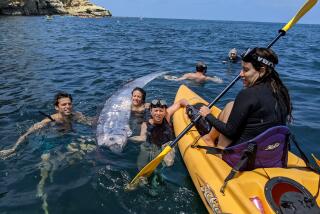Crowing over Baja’s roosters
- Share via
They’re not pretty and they’re not good eating, but from now through late fall roosterfish are the object of affection for hundreds of anglers heading for the East Cape, a stretch of prolific waters on the southeastern tip of Baja California below La Paz, where more than a few “Roosterfish Capital of the World” signs hang. Known for their dramatic comb-like dorsal fins, their odd tendency to repeatedly ambush large live bait to death in lightning-quick strikes and their ferocious fighting instincts, roosterfish, such as the one below, aren’t for the fainthearted. Bill Varney, a Huntington Beach-based roosterfish enthusiast and author of “Surf Fishing: The Light-Line Revolution,” recalls watching a pal hook one. “It spun every inch of line off his reel -- about 300 yards of 25-pound test -- and then ‘snap!’ And that was it. No fish. No line. I think it had been playing with Ed the whole time, not the other way around.” Roosterfish generally seek their prey in warm, shallow water that’s not boat-friendly. They can exceed 40 pounds (the largest ever caught was a 114-pounder near La Paz back in the 1970s). They are also bony and have dark, oily, undesirable meat. So it’s all about the thrill. “Roosterfish are one of the strongest fish we know of,” says John Mestrin, owner of Blue Water Tours and a veteran Baja fisherman. “They can be an incredibly exciting and beautiful fish to catch. Seeing it take a long run after your lure with its dorsal fin erect is a pretty amazing sight.”
-- Jordan Rane
More to Read
Sign up for The Wild
We’ll help you find the best places to hike, bike and run, as well as the perfect silent spots for meditation and yoga.
You may occasionally receive promotional content from the Los Angeles Times.






